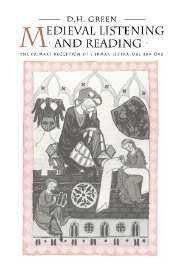Book contents
- Frontmatter
- Contents
- Preface
- List of abbreviations
- PART I Preliminary problems
- PART II Three modes of reception
- Introduction
- 3 Criteria for reception by hearing
- 4 Survey of reception by hearing
- 5 Criteria for reception by reading
- 6 Survey of reception by reading
- 7 Criteria for the intermediate mode of reception
- 8 Survey of the intermediate mode of reception
- PART III Conclusions
- Appendix Middle High German ‘lesen’ = ‘to narrate, recount, tell’
- Notes
- Bibliographical index
- Index of names
4 - Survey of reception by hearing
Published online by Cambridge University Press: 04 September 2009
- Frontmatter
- Contents
- Preface
- List of abbreviations
- PART I Preliminary problems
- PART II Three modes of reception
- Introduction
- 3 Criteria for reception by hearing
- 4 Survey of reception by hearing
- 5 Criteria for reception by reading
- 6 Survey of reception by reading
- 7 Criteria for the intermediate mode of reception
- 8 Survey of the intermediate mode of reception
- PART III Conclusions
- Appendix Middle High German ‘lesen’ = ‘to narrate, recount, tell’
- Notes
- Bibliographical index
- Index of names
Summary
The evidence for this mode of reception must now be discussed under the ten genre headings listed on p. 60, within each of which works are listed chronologically. Some cases are much weaker than others, but conversely many works, probably received by hearing, cannot be included for lack of evidence. Wherever possible works are discussed separately, but where the material is repetitive they are treated generically. The internal evidence for hearing works recited is largely focused on a verb like hoeren, which can however be used conventionally or metaphorically, so that we shall have to establish whether it is used literally of a given work: either when other criteria for hearing are present or when those for the intermediate mode are found (the audience is seen as reading or hearing the work, or as hearing it recited). This supplementary evidence helps to establish when hoeren is to be understood literally.
Functional literature
Magic charms and blessings had to be voiced to be effective. They were intended for one kind of recital or another: chanting or a low whisper.
For the latter cf. Ad equum errehet (373, 10: tu rune imo in daz ora) or, as a Christian parallel, the Züricher Arzneibuch (384). This written transmission of oral practice (normally resting on spoken contact between master and pupil) is quite exceptional.
Works meant for use in the monastic school are governed by the oral dimension of teaching, where the teacher may use a text as the basis of what he says to his listeners.
Information
- Type
- Chapter
- Information
- Medieval Listening and ReadingThe Primary Reception of German Literature 800–1300, pp. 95 - 112Publisher: Cambridge University PressPrint publication year: 1994
